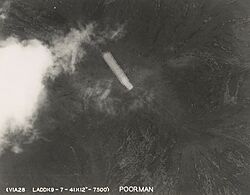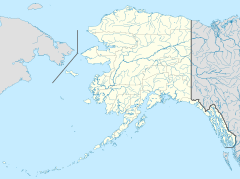Poorman, Alaska facts for kids
Quick facts for kids
Poorman
|
|
|---|---|

Airstrip at Poorman, 1941
|
|
| Country | United States |
| State | Alaska |
| Census area | Yukon-Koyukuk |
| Elevation | 502 ft (153 m) |
| Time zone | UTC-9 (Alaska (AKST)) |
| • Summer (DST) | UTC-8 (AKDT) |
| GNIS feature ID | 1408178 |
Poorman is a small, historic place in the state of Alaska, in the United States. It's known as an unincorporated community. This means it doesn't have its own local government, like a city or town would. Instead, it's managed by a larger area. Poorman is located in the Yukon-Koyukuk Census Area. This area is part of Alaska's Unorganized Borough, which is a large part of the state without regular county governments.
Poorman sits among the Kilbuck-Kuskokwin Mountains. It's right next to Poorman Creek. You can find it about 44 miles (71 km) south of Ruby, a city on the Yukon River. The area is about 502 feet (153 meters) above sea level.
Contents
A Glimpse into Poorman's Past
Poorman started as a busy place because of gold mining. People discovered gold nearby, and a mining camp quickly grew.
The Gold Rush Begins
In 1913, Poorman was founded as a gold mining camp. Many people came hoping to find their fortune. They would dig for gold in Poorman Creek and the surrounding areas. Life in a mining camp was often tough. Miners lived in simple shelters and worked hard.
Poorman's Post Office
As the community grew, it needed a way to send and receive mail. A post office was opened in Poorman in 1915. This was an important connection to the outside world for the miners and residents. The post office served the community for many years. However, it eventually closed down in 1932. This often happens when a mining camp's population shrinks.
Naming Poorman
The name "Poorman" comes from the nearby Poorman Creek. The creek was named first, and then the community took its name from the creek. The United States Board on Geographic Names officially decided on the name "Poorman" for the community in 1944.
Poorman Today
Today, Poorman is considered a ghost town. This means that most or all of its original residents have left. The buildings might still be there, but they are often empty. Ghost towns are like historical snapshots, showing us what life was like in the past. Poorman's story is a reminder of Alaska's exciting gold rush history.


